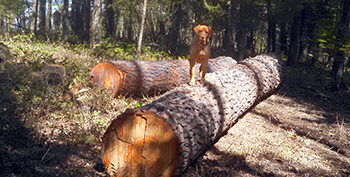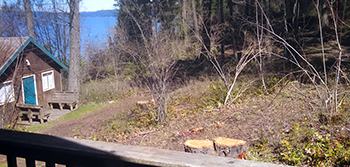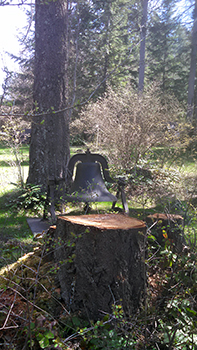| Search PNC News for stories of people and churches in our UCC Conference: |
|---|
Ritzville UCC listening session offers environmental insights
Mark Boyd discusses environmental concerns in North Idaho area
At a recent listening session, Zion Philadelphia UCC in Ritzville was offered an opportunity for PNC leaders to learn about environmental concerns from the perspective of Eastern Washington communities.
 |
Photo: The camp dog, Sage, stands on top of two trees cut down because of root mold and beetles Photo courtesy of Mark Boyd |
Mark Boyd, managing director at N-Sid-Sen; Christina Carter of Big Bend Electric Cooperative in Ritzville; Ron Jirava, a Ritzville wheat farmer, and John Hubbe, an engineer involved in cleanup at Hanford were other speakers. Mark and Christina’s stories are in this issue. Ron and John’s will be in upcoming issues.
Mark told how forests and mines affect the region as well as ministries at the PNC’s camp and conference center on Lake Coeur d’Alene.
“Forests affect us locally and regionally as we have in recent years experienced wildfires that have meant people lost homes and have filled the air with smoke,” he said, expressing gratitude for the snow pack this year.
Because it has been so dry, a big, 100-year-old Ponderosa pine fell last summer.
“No one was around, but I began looking and saw more diseased trees,” he said.
The trees have been diseased because of bark beetles and root mold in fir trees.
|
Open view from a cabin to the lake and a stump by the bell. |
On the 80 acres on the lake side of Hwy. 97, he has had 20 percent of the trees taken out because they were dangerous near buildings. Across the lake, Sweyolaken had to take out 80 percent of its trees because of root mold, Mark said.
“Now I can tell if a tree is dying by looking at the crown to see if its thinning and the pitch bleeding out,” he said. “What do we do to maintain our forest now the trees are out?”
One project is to remove the scrub brush to protect the camp from fires. Then they will plant larch, which is hard to kill, and cedar in wet areas.
“We cannot put fir back, because root mold likes young trees,” he said, “and pine is susceptible to bark beetles.”
Across Hwy. 97 to the east, N-Sid-Sen has 200 acres. It is working with a forester, the Idaho Small Free Farmers Association, the Spokane County Conservation District and Washington State University. They recommend doing some logging to manage the land, leaving a certain number of trees per acre. To cut diseased trees, they needed a variance from the Idaho Lands Council
Because of the Great Fire, or Big Burn, of 1910 in Idaho, Washington, Montana, Oregon and Wyoming, forest management practices were developed, recognizing the need to harvest.
Once controlled burns were used in forests, because pine cones do not release seeds without heat, he said, adding that agriculture also used fire for disease control and releasing seeds. With winters are shorter, beetles survive freezing does not kill root mold.
“Now we realize we need a balance between no fires and letting fires burn,” he said.
Mark expects the reduction of trees on the grounds may shock some campers.
Tree removal across the highway provides some income. Some of the trees logged were taken to mills. Some are being cut for firewood. They need to be split, so beetles don’t spread. Some are being chipped for trails.
Mark worked with Plants of the Wild in Tekoa for seeds and seedlings for native grasses he will plant in several areas.
“We cut down trees with root mold, but did not need to pull the roots out, because killing the top of the tree kills the mold,” he said.
Mark also discussed water quality issues, which arose during the February Environmental Justice Training Retreat. Wallace, Kellogg and other area communities grew because of mining silver. Miners left piles of tailings, other minerals they did not want. As a result, there are heavy metals in the bottom of Lake Coeur d’Alene.
“It’s being crystal clear is an illusion,” he said, “because there are contaminants. It is safe to swim in areas, such as N-Sid-Sen, but not in areas near the Coeur d’Alene River or Harrison. The lake is still affected by toxins.”
The Coeur d’Alene River is a Superfund Cleanup Site. The Coeur d’Alene Tribe and the Kootenai Alliance are working with the Environmental Protection Agency, with the Idaho Department of Lands, the Idaho Department of Water and the Kootenai County Water and Health Departments.
The tribe is pushing for the cleanup, so when swans land as they migrate north, they can drink the water and be safe.
For two years, campers on float trips on the Coeur d’Alene River have taken garbage bags and picking up things like cans and trash from the river bed. Now they find fewer things.
Three of the big mines are still open. Mark said they were not challenged in the past about how they operated and what happened to the tailing piles. Increased interest in cadmium and other precious metals for cell phones drives today’s mining.
“The Silver Valley was named for the silver and other precious metals mined and still there,” he said. “Regulations had been lax. There is also concern of people about having a livelihood. Environmental justice is concerned about what the toxins do and about how people can earn a living.
“There has been lead in water, in yards and in people, and people can be tested to treat and remove the lead, but many don’t want their children tested because they don’t want to acknowledge that their work may be causing lead poisoning in their children,” he said.
For information, call 208-689-3489 or visit n-sid-sen.org
Copyright © April 2016 Pacific Northwest Conference News


